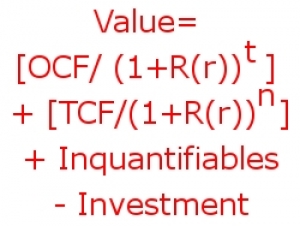Blog: Fixing Problem and High-Risk Projects
 Have you ever had a boss that simply wants to stand in your way? They avoid making even the smallest decision, never providing enough information to understand their objections. It is more common than most of us would imagine. In fact, this behavior is the central to every sales interaction. Even though you may be repulsed at thinking of yourself as "selling" to your boss, that is exactly what is required with any idea you are pushing. Therefore, it makes perfect sense to employ the same techniques used to sell large systems. If you think this is rubbish, as one of my esteemed readers once eloquently said, I will posit that you are already using sales techniques, just the wrong ones—the ones car dealers use. Changing this approach will subdue your unruly boss
Have you ever had a boss that simply wants to stand in your way? They avoid making even the smallest decision, never providing enough information to understand their objections. It is more common than most of us would imagine. In fact, this behavior is the central to every sales interaction. Even though you may be repulsed at thinking of yourself as "selling" to your boss, that is exactly what is required with any idea you are pushing. Therefore, it makes perfect sense to employ the same techniques used to sell large systems. If you think this is rubbish, as one of my esteemed readers once eloquently said, I will posit that you are already using sales techniques, just the wrong ones—the ones car dealers use. Changing this approach will subdue your unruly boss

Change is difficult. Regardless of who you are, it is tough. Recently, I challenged readers of this blog to improve how they tie their shoes. I can confidently wager that a large majority have stayed with their old habits. It takes significant force to reprogram out brains, affect the cultural inertia, and gain acceptance to change, tolerance of occasional mistakes, and, eventually, achieve an organization steeped in transformational principles. Nowhere is it more apparent than when delivering projects that alter the way people perform daily tasks. The reason is that, all too often, the goal is to deliver the project; it is someone else's job to gain adoption.

Why would anyone need to teach a group of managers how to tie their shoes? It seems improbable anyone could make it to this point in his or her career lacking this simple skill. However, I feel quite confident that a vast majority of project managers, managers, leaders, and probably you, are improperly lashing your laces. This prognostication will go one step further stating that even after proving a better method, they, and you, will be unwilling to put forth the effort to change. Adopting change, beyond just tying your shoes, is at the root of our inability to improve many of our business processes. Furthermore, studying this behavior and the subsequent difficulty of maintaining a new and better method will help us understand the high recidivism rate.

The other day, someone said, once again, that an issue we were discussing was like pushing string. She said it with the sigh of resignation in her voice. I understand the metaphor, but the people saying it are stuck looking at the problem wrong. Immediately, two solutions to their dilemma come to mind. First, add a little water, freeze the string. Voilà! Push that string wherever your little heart desires. If that is too hard, then roll it into a ball or put it on a spindle. Now, we can push, roll, carry, and even throw it. The problem is the predisposition to the inevitability of the issue—there is no reason to look for a solution because it is out of our control. Worse than that, we are so defeated that we rarely ask the question "Why are we trying to push that string?"
A project manager's job is to deliver value. Achieving the original schedule, budget, and features is meaningless if the customer does not receive value. As with all simple statements, this much easier said than accomplished. Projects managers must assemble adaptable teams that use flexible, lean methodologies. Arrogantly selling the latest technology or tool is narcissistic. Focus on the customer. Be vigilant at ensuring the information is always available for the customer to reassess the project's value and for the project team to reevaluate their proposal.
"People say I am indecisive, but I am not so sure about that." I have seen this quote attributed to a former US President, but I doubt he actually siad this. First, it is too intelligent a comment for him and, second, he is far from indecisive. The liberal pundits trying to attribute that quote to him confuse indecision with defective decision making. You can figure out who the President is on your own; however, it is irrelevant. This article is about leadership not politics. Organizations confronted with a decision-challenged individual in a leadership role, is adrift in the sea of serendipity. They bobble around having no direction.

"I just want to be a project manager. I don't want all that responsibility." The room was silent, save a few exasperated sighs. We all looked around trying to figure out how we would handle the comment. However, there are many levels of project management maturity and only the highest levels require leadership. In fact, the prominent certification process—PMI's PMP®—has little to do with leadership until 2015. So where do we learn about leadership and how can we improve our leadership skills?

The system integrator is the magical troupe that works with the customer and the software vendor to deliver a project's desired functionality. They cut through the vendor's promises while controlling the customer's expectations to create a successful deployment. Mike Krigsman refers to this triad as the Devil's Triangle; all three parties are culpable in the failure and share in the success. However, the system integrator is responsible for holding the three together to achieve successful delivery. The cornerstone to this relationship is a thoughtfully built contract.
I have always enjoyed being part of team building exercises. The one where you close your eyes and fall backwards hoping that your team members catch you is my favorite. It reminds me of an amusement park ride. There is always the thought in the back of my mind that some trickster will let my head crack on the floor. I think it adds more excitement. However, team building exercises only go so far and normally fail to reach their objective. They are too transient. The event happens, the manager checks off the list to show the task is done and he or she goes back to managing the team with status reports, task assignments by email and visiting people only when something goes wrong.
Filling Execution Gaps
Available Worldwide |
|||||||||||||||
.png) |
|||||||||||||||
|
Filling Execution Gaps is available worldwide. Below are some options.
|
|||||||||||||||
 Limited Time Price $20.99 |
|||||||||||||||
 |
|||||||||||||||
| Book or Kindle |
|||||||||||||||
 |
|||||||||||||||
 |
|||||||||||||||
 |
|||||||||||||||
 |
|||||||||||||||
| Worldwide: Many other book sellers worldwide. |
Rescue The Problem Project
For a signed and personalized copy in the US visit the our eCommerce website.
 |
||
| Book sellers worldwide. | ||
Other's References
- New PM Articles for the Week of November 9 – 15, The Practicing IT Project Manager, November 9, 2015
- The Argument for Disbanding Your PMO, Accellerated IT Success, Nov 13, 2015
- New PM Articles for the Week of September 28 – October 4, The Practicing IT Project Manager, October 4, 2015
- Episode 332: Project Sponsor Challenges and Solutions, PM Podcast, Cornelius Fichtner, September, 2015
- New PM Articles for the Week of December 1 – 7, The Practicing IT Project Manager, December 7, 2014
- How to buy Project Management Consulting Services: Service as a Product (SaaP), Guerrilla Project Management, Samad Aidane, December 2, 2014
- Episode 275: Your Project Statement of Work is Missing a Comma!, PM Podcast, Cornelius Fichtner, June 14, 2014
- State Invites 10 Firms To Shift Cover Oregon To The Federal Health Insurance Exchange, Oregonian, Portland, Nick Budnick, May 28, 2014
- Decision To Scrap Or Salvage Cover Oregon Health Insurance Exchange Poses Risks Either Way, Oregonian, Nick Budnick, Portland, April 9, 2014
- Cover Oregon Consultant: Fix For Health Insurance Exchange Could Take $40 Million, 21 Months, Oregonian, Nick Budnick, Portland, April 4, 2014
- Episode 205: Rescue The Problem Project, PM Podcast, Cornelius Fichtner, June, 2013
- Episode 206: How to Keep your Project out of Trouble, PM Podcast, Cornelius Fichtner, May, 2013
- How to identify, prevent, and recover from project failure, Accellerated IT Success,April 2, 2013
- Episode 260: The Seven Steps to Rescuing the Problem Project, PM Podcast, Cornelius Fichtner, January. 2014
- New PM Articles for the Week of August 6 – 12, The Practicing IT Project Manager, August 12, 2012
- New PM Articles for the Week of June 11 – 17, The Practicing IT Project Manager, June 17, 2012
.png)
 Twitter
Twitter Facebook
Facebook RSS
RSS Linkedin
Linkedin


.png)